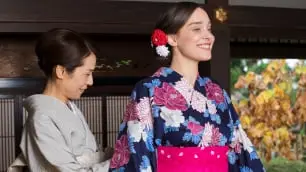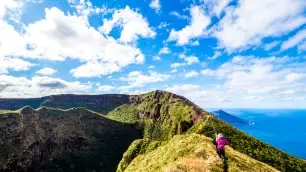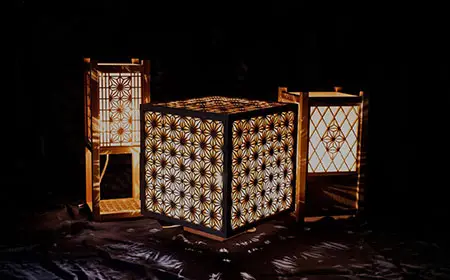
UNCOVERING CULTURE AND HISTORY IN THE GREAT OUTDOORS
Explore Mount Mitake, one the most sacred mountains in Japan, with some expert climbers. Only a short journey from central Tokyo, it is also renowned for its stunning panoramic views. Attendees can also stay at a beautiful historical lodging.
Teeming with unspoiled mountains, mystical forests, and crystal-clear waters, Okutama should be on the itinerary of all lovers of the great outdoors. Although located a mere two hours from the diverse delights of central Tokyo, it’s truly a world away, the epitome of tranquility.

Mt. Mitake is one of the area’s highlights, thanks to its breathtaking nature and rich culture that dates back to ancient times. Situated in the Chichibu Tama Kai National Park, the peak offers an opportunity to rejuvenate body and soul through hiking, learning about local landmarks, and staying at a traditional shukubo (lodging house for shrine visitors).
The mountain is considered sacred and has long been worshipped as a god that could grant bountiful harvests and protection from disasters. This belief is evidenced by the giant torii gate at Takimoto Station that marks the start of the trail to the summit. Walkers can begin their climb here or ride the Mitake Tozan Railway, one of the steepest cable cars in the Kanto region, to Mitakesan Station. From there, the route passes through the quaint village that is home to around 130 people, where participants of this experience will spend the night.
The accommodation is at HIGASHIBABA (Baba-ke Oshi-jutaku). A tangible cultural property of Tokyo dating from 1866, the building features a hip-and-gable thatched roof and traditional interiors including Shoin-style tatami rooms and an inner shrine. It is also the home of the Baba family, whose head member is a 14th generation oshi, a person dedicated to providing lodging for visitors to the shrine.


Baba-ke Oshi-jutaku is but one of the oshi-managed houses that have provided lodging in the village since the Edo period (1603–1867). Centuries ago, the role of the oshi was to cleanse worshippers’ souls so they could become closer to the gods during their visit, but it has changed over time.
In response, the Baba family has launched the totonoinototo lodging experience, designed to draw on ancient practices while creating something new and valuable for people in the busy modern age. The goal is to condition the body and mind to a “just right” state through the experience of ten conditions. These include being cleansed by undergoing an oharai (purification by a Shinto priest) and drinking herbal tea. The meal, osagari oju, is served to receive offerings used for prayers to the gods.

Visitors can also experience the effects of a hand bath made using various medicinal herbs. A vast array are used, tailored for different conditions, such as detoxification, heat retention, and allergy relief. The fragrance soothes and the steam opens up the pores to refresh the skin.

After a top-quality sleep, visitors receive a sendoff of a morning meal and spiritual parting words from the oshi. Their destination is Musashi Mitake Shrine, one of the oldest Shinto shrines in Japan, dating from around 90 BC.
The approach to the shrine retains the appearance of bygone days, with several sets of steps lined by giant cedars said to have played a role in cleansing the souls of visitors for centuries. At the chozuya (purifying water basin), visitors will notice a separate basin and ladle marked for use by pets! An extremely rare phenomenon in Japan, this setup reflects the deity enshrined here: Oguchimagami (known widely as Oinusama), a Japanese wolf that attracts many dog-loving visitors and their canine friends.

According to legend, Oinusama became honored after a white wolf guided a lost Yamato Takeru, a hero from the Yamato dynasty, to safety almost 2,000 years ago. Wolves, therefore, take the place of the traditional komainu (lion-dogs) at the shrine gate and in the honden (inner sanctum), another extraordinary custom.

With the establishment of the Edo Shogunate, the worship hall was rebuilt in 1606 so it would face eastwards, thereby providing protection from evil on the western side of Edo (modern-day Tokyo). Because of this defensive role, Musashi Mitake Shrine has remained important culturally and spiritually to this day. The main hall was rebuilt in 1878.
At the back of the shrine, a sign and two trees adorned with shimenawa (lengths of rice straw rope) and shide (decorative white paper) mark the spot from which visitors can see the nearby peak where Yamato became disorientated. Looking out over the rugged natural landscape, evident even from far away, visitors can understand the danger he faced and the gratitude he must have felt to the wolf when he constructed the shrine.

During the hike led by Mr. “Yacu” Takahata, professional river rafter and mountain climber, visitors can hear the background and various stories related to Mt. Mitake, creating a profound experience different from simply climbing a mountain. The hiking courses can be tailored to various needs, from beginners to advanced hikers.


Moving onward, the network of trails reveals breathtaking panoramic views and distinctive natural wonders. Look out for Tengu no koshikake, a tree said to resemble the bench of tengu goblins who are regarded as guardians of mountains and forests, and Ayahiro Falls. This cascade of pristine mountain water flows into a valley filled with picturesque moss-covered rocks known as the Rock Garden, another serene natural wonder.

With such a wide range of mood-boosting experiences, visitors will feel renewed for their homeward journey, returning with warm memories of their stay in another unique part of Tokyo, full of nature and culture.
*The experience introduced in this article is a special arrangement by Mr. Takahata "Yacu" and HIGASHIBABA. Please contact the email below for more information.
Contact about hiking experience:
Mr. Masayuki Takahata "Yacu" (River Base HALAU)
yacustyle@gmail.com
Contact about the totonoinototo lodging experience:
Mr. Katsumi Baba (HIGASHIBABA)
info@higashibaba.com





























